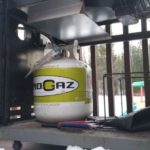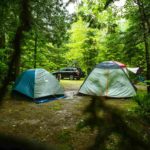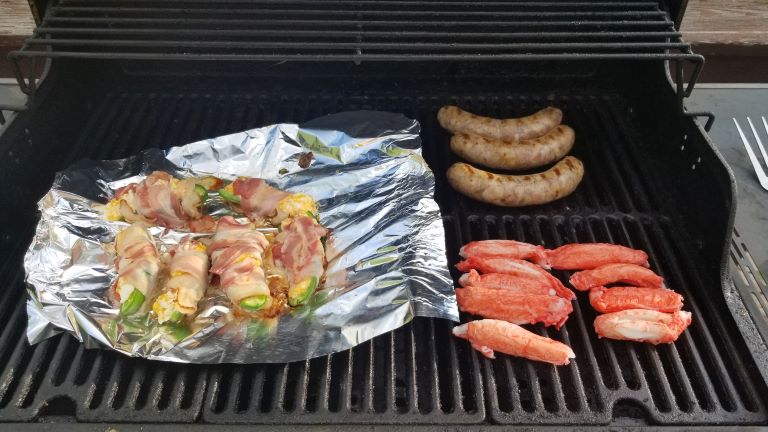
How to Cook Over a Campfire
Cooking over an open campfire is one of my absolute favorite things about camping. Being outside in the fresh air and having a cold drink while preparing a meal is so relaxing to me. On top of that, the food just tastes better!
For the most part, campfire grilling isn’t overly difficult, provided you’ve got the right tools and setup for the job. That’s why we’ve created this list of tips, items and tricks to give you the know-how to safely begin campfire cooking.
What can you cook over a campfire?
You can cook almost anything over a campfire as long as you have the right tools and camping equipment. Grilling is best for meat and tin foil meals. Soups and stews can be made in the right type of pot. Frying foods like bacon and eggs can be done in a frying pan. You can even bake bread and cakes over a campfire with the proper method.
Where to Place your Fire Pit
Of course, you can’t cook over a fire pit if you don’t have a campfire. So step one is preparing a spot to place your fire pit.
Choose a location far enough away from trees and other vegetation that might catch fire. In general, being 8 to 10 feet away is good.
Brush away any leaves, pine needles etc. from your fire pit area so that you’ve got some dirt to build your fire on as well as a safe buffer area so that flames can’t migrate outside of the campfire area.
How to Build a Fire Pit Suitable for Campfire Cooking
Once you’ve chosen a good area for a fire pit and prepared the ground, it’s time to start building it. To do so, you can either gather some stones and rocks or you can use bricks, patio pavers or a metal ring for the outline. You can also elect to purchase a fire pit for your backyard so you can move it out of the way for grass cutting.
Next, place the stones around the perimeter of the fire pit. If you’re using smaller stones, place rows on top until you have a height of one or two feet. Flat stones work the best for stacking and will be less likely to fall over with time.
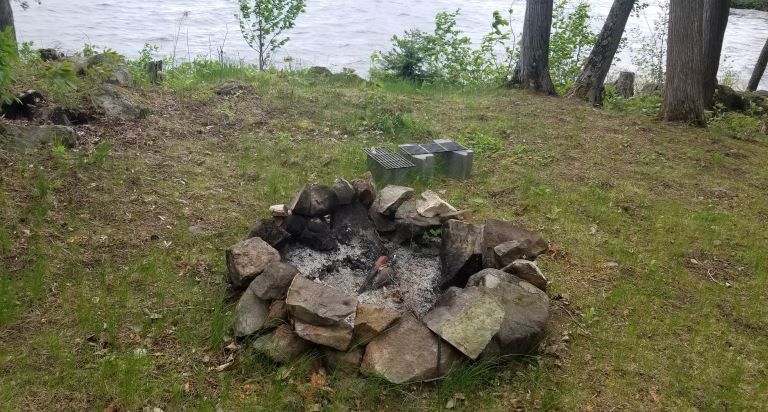
Building A Campfire Perfect for Cooking
Now that you’ve got the fire pit setup, you’re ready to get a campfire going so that you can start grilling. But, in order to regulate temperature and cook food to perfection, you need to be cooking over hot coals, not flames. So, it’s important to have a fire going well in advance of your cooking time so that the wood has time to burn down to coals.
Burning the best wood for cooking
The type of wood you burn has a direct impact on the heat of your fire and how well it will cook the food. It’s always best to use dry, seasoned firewood which will burn the most efficiently and cleanly. Wet wood will create a lot of smoke and will not generate a suitable amount of heat.
For more info on picking the best firewood for your campfire check out this post: Picking the best wood for campfires
Making a Campfire
To get your fire started, place some very dry tinder material on the ground inside the fire pit. This can be birch bark, dry twigs, sawdust or crumpled up newspapers.
Next, add in your kindling wood. Kindling should be dry, dead softwoods like pine or spruce, chopped into thin pieces and placed over top of the tinder. Now light that up and let it begin to burn.
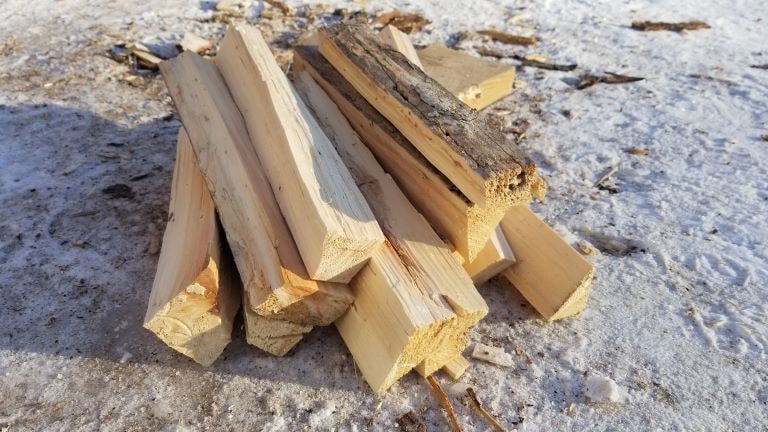
Once you’re sure that the kindling will continue to burn without issue, place a few pieces of your firewood on top while making sure that airflow is not restricted. A good draft will ensure that the firewood ignites and continues to burn.
When can you cook over the campfire?
Once the firewood has burned down and there are no tall flames left, you can start cooking. There should be a nice hot bed of coals at the bottom of the fire pit. Place your campfire grill over the coals by resting it on the rocks of the fire pit or on the newly placed firewood logs.
Campfire Cooking Tips
Now that you’re set up, you’re ready to cook some delicious food over an open campfire. Here are a few tips to help make your campfire grilling experience seamless and enjoyable.
Use Ashes for Temperature Control
It’s easy to find yourself burning food when cooking over a campfire. You can’t simply turn a dial to reduce the heat. If you find that your food is cooking too fast and burning, you need to use what’s available to you at the time. Scooping some ashes on top of the coals will blanket them, essentially turning down the heat output.
Be Prepared with the Right Equipment
You won’t know that you need a good pair of grilling gloves and some long tongs until you’re trying to fight your steak out from a heaping hot flame. Keep them close to your fire pit so that when you need them they are readily available. A good pair of work gloves can also do the trick splendidly.
Start Early
It’s going to take some time to get those nice hot coals that are needed for cooking. Make sure to start the campfire early enough so that it’s ready when it’s time to cook.
Manage your wood supply and keep low flames
Once you’ve got some nice coals, you want to maintain them by keeping a steady supply of wood to the fire. However, you don’t want to create a roaring fire that will char your food and cause a lot of smoke. Add wood to the outside edges of the coals and it will continue to feed the fire pit.
Adjust Cooking Times
Remember that you are cooking outside in the elements and so food won’t likely cook as fast as you are used to. Be patient and adjust cook times to allow food to fully cook through. Cooking foods to their recommended internal temperatures is important for your safety.
Bring Aluminum Foil
Aluminum foil is great for cooking over a fire pit for many reasons. Number one, it keeps foods from falling through the grilling grate and into the fire. For this reason, it’s perfect for cooking things like potatoes and onions. It also keeps any flare ups from charring your food, plus it is easy to remove and you can even eat right from the foil packet.
Meal Prep at Home
I personally enjoy doing most of the chopping and setting up at the campsite. However, planning your meals so you can ensure you have all of the needed ingredients should be done beforehand. This will also help you to plan how much of everything you need so that you don’t over pack or under pack.
Certain foods like tin foil packet meals are also easier to prepare at home so they are ready to throw on the campfire. One of my personal favorites is having breakfast burritos made at home and wrapped in aluminum foil so they are ready to heat on the campfire.
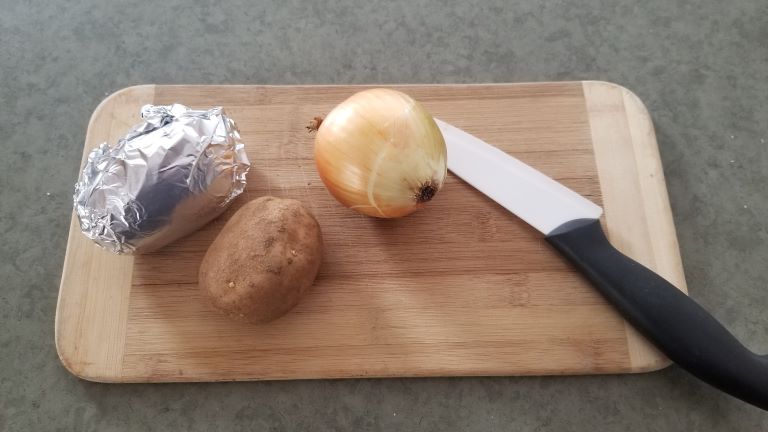
Don’t cook over flames
It may be tempting to put your food right in the flames to cook it faster. Especially if it seems to be taking a while. Unfortunately, it won’t actually cook any faster. It’ll simply burn the outside and leave the inside uncooked. Just think of all of those past marshmallows that you’ve caught on fire.
Spray bottle for flare ups
You’re bound to get the odd flame flare up as you add wood to the fire. Before it gets to burning your food, move the food out of the flames as much as possible and spray a mist of water over the flames.
Make use of a Swivel Grill
If you’ve got the space for it, a fire pit swivel grill works wonders. Most are mounted into the ground with a stake, allowing the grill to swivel around the stake. You never have to worry about logs shifting or your campfire grilling grate and food falling into the fire. It’s also easy to move your food around to avoid flames and position it over the best coals.
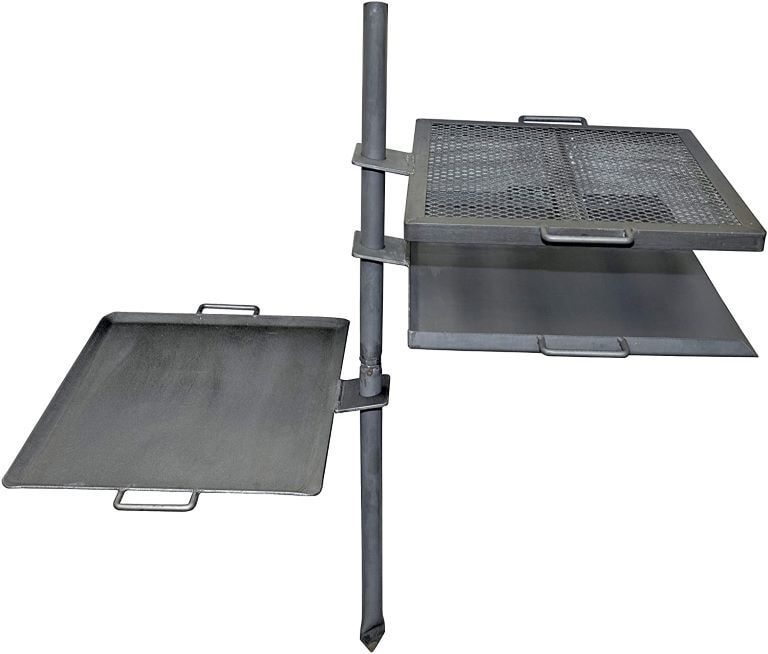
To see a list of the most unique swivel grills for open fire cooking grills check out this post: Fire Pit Swivel Grills
A Dutch Oven for Soups and Stews
Campfire cooking goes way beyond the traditional grilled meals. While a campfire grilling grate is perfect for grilling meats and veggies, if you want to expand your meals a Dutch Oven is where it’s at.
A Dutch Oven is a cast iron pot with a heavy lid and a solid handle. It can be positioned right on top of the hot embers or you can place it on a grill or even hang it over the campfire. Because it can withstand the heat you can even place hot coals on top and all around it to create a makeshift oven where you can bake desserts and bread. Dutch Oven cinnamon buns are one delicious dessert you can make.
A Cast Iron Pan for Frying
Just like the Dutch Oven, a cast iron frying pan has it’s specialty uses as well. A frying pan is nice to have for making eggs and bacon in the morning. A well seasoned cast iron skillet can add loads of flavor to your meals as well. It can be placed right on top of a grilling grate for cooking. Just remember to use your gloves when removing it as it will be hot, hot, hot.
Campfire Grilling Baskets are a Sandwich’s Best Friend
I don’t know how many times I’ve dropped my sandwich in the fire trying to grill it using a tree branch as a grilling stick. A campfire grilling basket takes all of the risk out of it by enclosing your sandwich inside. You also get those nice toaster grill marks from the grate.

